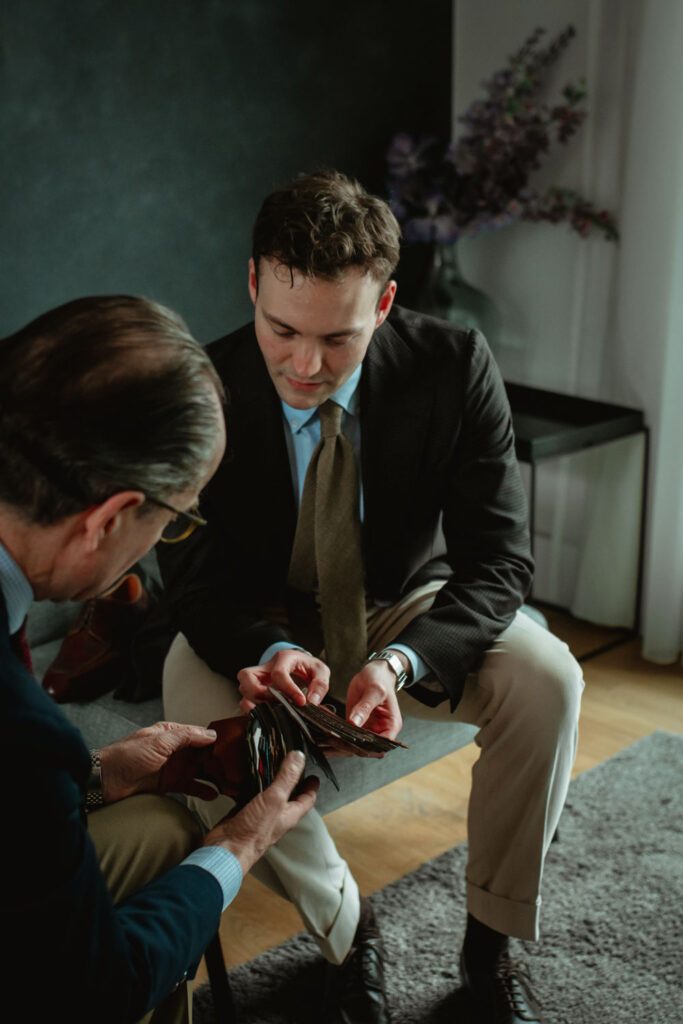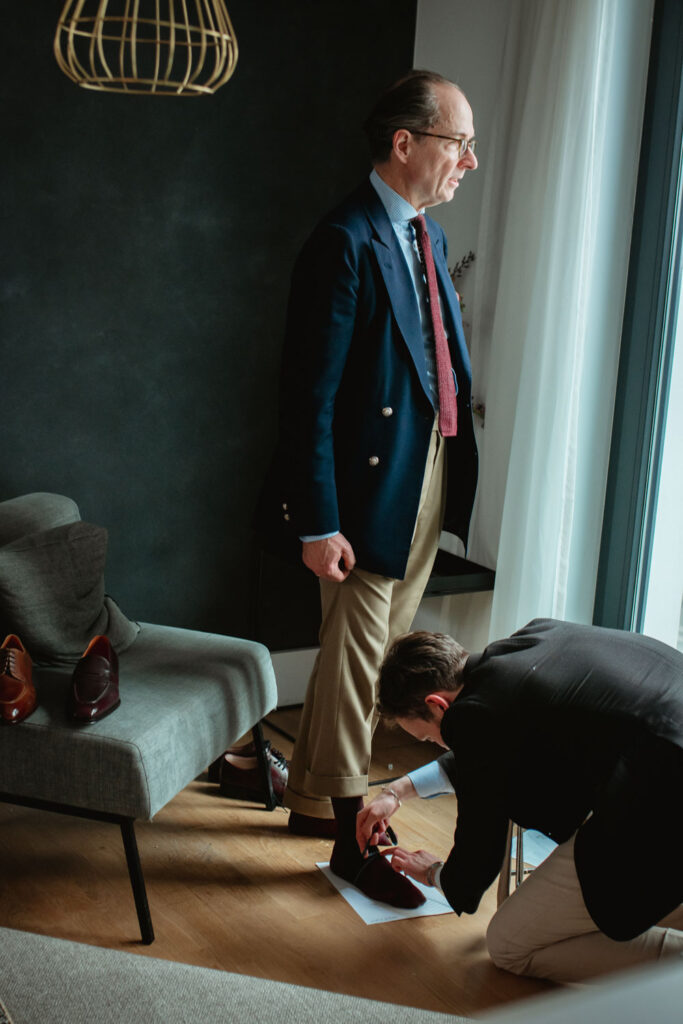Simon Wegmann, the Frankfurt based shoemaker behind Wayman Bespoke, is connecting with new customers online. Read our interview with the founder of the company.
Photographer: Volodymyr Duda
How did you come up with the idea for this concept?
I have relatively oddly shaped, narrow feet with a very low instep. This has made finding suitable shoes difficult and makes buying classic leather shoes off the rack impossible for me. After once again being put into a shoe three sizes too small by the sales lady at the shoe store with my toes curling, just so that the lacing gripped my foot, I decided that this could not be the solution. Good bespoke shoemakers are rare in Germany, and as I’m sure many are familiar with — once you start digging into a topic — you only want the best of the best. One dreams of elegant English, Japanese and French bespoke shoes. However, these shoemakers were not only unattainable for me in terms of price, but simply because of their location. Traveling for the measurements and further fittings cost not only money but also a lot of time and effort. At that time, I quickly realised that I surely was not the only one with this problem and started looking for a business model where I simply take measurements myself, send them to a shoemaker so that the finished pair of shoes is delivered to my doorstep. I was surprised that this model didn’t exist and none of the shoemakers I contacted were willing to tackle such a project with me. However, the deeper I looked into the subject myself, the more I recognised a gap in the market which I thought would be quite easy to fill. At the time, especially in retrospect, this was certainly very naive thinking and it took almost two and a half years from the time of the idea to the successful implementation. But then to have the first actually well fitting shoe on my personal last, completely handmade, on my foot, was an incredible feeling for me and the daily feedback by satisfied customers only validates my intention.
What was the biggest hurdle in the development and foundation?
Had it not been for my personal desire to receive a pair of shoes that fit and my passion for the subject, I’m sure I would have given up at several points in the development of the program. The concept of the self measuring process, the creation of lasts with continuously successful results at a distance, all in all, took almost two and a half years. In addition, it was a great challenge to find a workshop that was willing to take on such an ambitious project and believed in my idea with equal passion. Over the years I contacted more than 200 to 300 shoemakers, last makers and factories with many test samples, of which just as many failed. However, during this intense time, through good conversations, many questions and newly made friends, I learned a lot about the subject and received great help and support.
Where were the biggest weaknesses in the initial phase? Rather in the measuring? Or in trying on the shoes?
A solution for successful self measuring with consistent quality of the basic data was quickly found through the development of the systematised guide and associated video. We also require the classic measurements that a normal bespoke shoemaker uses and takes, our system is only more conceptualised and simplified. The great difficulty was much rather to make a last from these measurements that actually fits. With increasing experience, which of course only came over time and lots of testing, I was then able to develop a system that automatically converts the foot measurements into the data for last creation. Here we now use a mixture of 3D technology as well as manual work to achieve the best possible result. Trial shoes made from surplus materials and with a simple cemented construction additionally ensure that no mistakes are made and the last is further adjusted until I and the customer are satisfied with the fit and appearance.
How did the basic shapes of the Bespoke lasts come to be? After all, your shoes, like all bespoke shoes, have a certain look.
Obviously the look of a last depends on the foot dimensions of the wearer. But also and most importantly on the purely aesthetic toe shape of the last. Since the measurements are a given, each customer can then choose a toe shape for his shoe. Here I have made a selection of three shapes from the start, which — in principle — should cover everything one could ask for. Of course the toe shape and aesthetics can additionally be modified to the individual liking of each client. With my angular “Chiseled Square” as well as the very elegant round and somewhat narrow toe “modern round” I have certainly been inspired by Japanese and French shoemakers, but tried to make the lasts not too pointy and long, which corresponds to my own taste. These toe shapes are especially popular with my US and Asian customers. Europeans, and especially Germans, usually prefer my classic round last, which has a little more volume and substance and is more reminiscent of English lasts.
Can you tell us something about the workshop?
As mentioned earlier, finding the workshop was one of the biggest challenges for me. From the beginning, I didn’t really care in which country the shoes were made. I source the materials myself in Europe and the USA anyway, all from well-known tanneries. Today, how something is made is much more important than where something is made. The goal was to find a workshop that would meet my quality demands for a handmade shoe, would be flexible enough to meet (almost) every customer request but also be able to grow with me long term. Finally, through a contact and a recommendation, I landed with my workshop in Shanghai, where, amongst others, English and Italian trained shoemakers with a lot of passion and ambition make shoes by hand. Here I implemented new standards, had new tools made and changed some components in the construction of the already great shoes. This way, I was able to raise the production to a level that meets my own requirements for bespoke shoes and doesn’t have to hide on the world stage of shoemaking. Of course, the fact that I live in Germany and my manufacturing is in Shanghai presents a challenge that is overcome through my assistant on site who gives me daily updates and performs my quality controls. This way deadlines and standards can be met without any issues. The final quality control is always done by me in Frankfurt, before the shoe is delivered to the customer.
Which shoe model is the most popular?
A particularly popular shoe model can hardly be identified. Many first-time customers still commission a quite conservative dark oxford made of smooth leather and only become a bit more fancy with subsequent models. These are mainly customers who previously had major problems with the fit of ready to wear shoes and are now building their shoe collection from scratch with me. However, the Oxford is usually followed very quickly by more casual models, such as Norwegians or loafers, which certainly fits the current „casualisation“ trend in the world of menswear. On the other hand, many customers use the option to create their own design and love my program more for the creative freedom to create their dream shoe.
How much can the customer customise his shoes?
Ordering a shoe usually starts with the model. Here, one of our many house styles can be chosen, which should covers all classic and well-known models. From the Adelaide Oxford to tassel loafers all the way to Balmoral Boots. In addition, I offer the service of developing an individual design, where there are no limits to the customer’s ideas. This option is popular when customers have a specific design in mind, but can’t find it ready to wear. The toe shape, which can also be freely determined, also has a great influence on the appearance of the shoe. A large selection of various calf, suede and grained leathers in many colors goes without saying. In addition, the heel as well as the sole can be individually determined in type, shape and color. Thus, in addition to the classic straight, there are two pitched heels to choose from, quite typical for well made bespoke shoes. Also the sole can be configured as a so-called narr“ow beveled waist”, or as a “fiddle waist”, meaning a slightly more angular tapered waist, which both provide more support for the arch of the foot. Perfectly fitting shoe trees based on the custom last, as well as metal taps or rubber top soles protecting the sole, as well as brass initials on the waist, can be ordered for an additional charge.
What do you recommend to customers who order from you for the first time?
Many recommend a black oxford — as the basis for a classic men’s wardrobe — when commissioning a bespoke shoe for the first time. However, I personally would always recommend choosing the shoe that you can get the most use and wear out of, as this is where you can benefit the most from a good fit. Especially today this is in very rare cases still the black oxford and much more often the casual loafer, derby or chukka boot made of suede or grained leather, which can be worn comfortably with sports combinations and possibly even with a pair of jeans. The first shoe is a very individual decision and must fit the lifestyle as well as the clothing style of the customer, which is why I like to advise each customer personally, even if only by e-mail, chat or phone call. The personal contact is very important to me personally and I would therefore recommend every customer to arrange a consultation before ordering.
In Germany, you can also have your feet measured in person at trunk shows. Does this make a difference in terms of the result?
I have only been working with trunk shows for a short time and have been offering my shoes exclusively online for most of that time. From the short experience I have had, there is not a significant difference in the outcome when taking measurements. However, it goes without saying that some customers are much more comfortable not taking measurements themselves and I always enjoy the personal contact with shoe enthusiasts. Much more important than the measuring itself is the fitting and adjustment of the first trial shoe. Here it is definitely easier for me to check the fit if I can do the fitting in person, touch the shoe, see it in motion and sometimes even cut it open. Doing this at a distance works just as well, but in many respects requires the customer’s assessment and willingness to work with me in order to uncover critical aspects of the fit.





